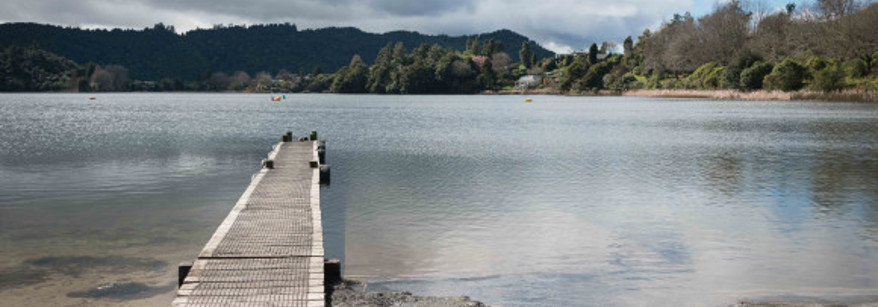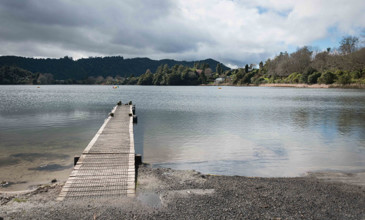Independent Commissioners acting under delegated authority from the Bay of Plenty Regional Council made the decision on 7 September 2023 to grant the applications for existing previously consented and previously unconsented structures in, on, over or under the bed of Te Rotoiti-kite-a-Īhenga (Lake Rotoiti) and Te Ohautanga ō Pōtaka Tawhiti (Ōhau Channel).
Any temporary or permanent structure where some part sits in, on, under or over a lake is considered a lake structure. Examples include jetties, boat ramps, boat sheds, moorings and retaining walls.
Below you can find information on existing and new lake structures as well as the different landowners you may need to interact with when getting resource consent. Alternatively, you can read our summary document.
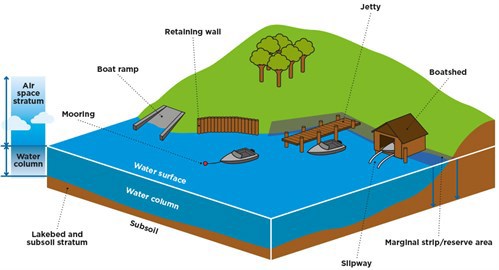
Existing lake structures are those which existed prior to the Te Arawa Lakes Settlement Act 2006 and remain unchanged. There are numerous existing structures sitting in, on, under or over Rotorua’s lakes. You need a current consent for these structures and to protect the environment, you cannot make changes to the footprint or carry out maintenance without applying for a new consent or notifying the Regional Council prior.
To transfer a resource consent to another party, please complete a Resource Consent Transfer Form.
Please note that this definition differs from that in our RMA and Building Charges Policy which states that when re-consenting existing unchanged lake structures – the $775 application deposit fee applies to all previously consented, unchanged lake structures whether or not they existed prior to the 2006 Te Arawa Lakebed Settlement.
Renewing my lake structure consent
Many resource consents for lake structures in the Te Arawa Rotorua Lakes area are due to expire by December 2020. If no changes are being made to the footprint of the structure, consent holders can apply for a new consent. To make the replacement consent process as easy as possible for consent holders, we are simplifying and streamlining it on behalf of the Te Arawa Lakes Trust, Rotorua Lakes Council, Department of Conservation (DOC) and Land Information New Zealand.
We are sending packs to lake structure consent holders in batches, lake by lake, based on consent expiry date. The packs outline the replacement consent process, what needs to happen by when and include the relevant forms. These forms need to be returned to the Regional Council within six weeks of receiving them.
Applying for a replacement consent
To simplify the replacement consent process, we are sending out customised information packs to consent holders. Separate lease forms will also be included in these packs on behalf of lake/lakebed owners and managers for the occupation of your structure on land they own and manage.
Consent holders would normally need to apply for a replacement consent before their current consent expires. Because the replacement consent process for lake structures is being streamlined, and consents are being managed in batches, there is more flexibility. Instead consent holders must return the relevant forms within six weeks of receiving them.
Lake Structures built post the 2006 Te Arawa Lakebed Settlement, unconsented lake structures, lake structure extensions or removal of vegetation (in conjunction with maintenance) all require a new consent and are not included in the streamlined process.
Existing unconsented retaining and protection walls are an exception, and you can apply for consent for these if you are already going through the replacement consent process for other structures. It’s best to apply for these at the same time so that you will not need to individually approach the various affected parties or initiate a cultural effects assessment.
Why resource consent is needed
Resource consents allow people or organisations to do something that could impact our environment. Structures (existing or new) that sit in, on, under or over the bed of the lake are identified as having an environmental effect in sections 9 and 13 of the Resource Management Act 1991 (RMA). Managing these structures through the resource consent process helps ensure the number of structures is limited, they are kept to a safe standard and any environmental impacts are kept to a minimum.
While a resource consent provides for the use of a structure, under the RMA, your structure(s) also occupies land or lake bed/and/or the water column which requires permission from the landowner or land manager. Therefore, in addition to obtaining a resource consent, all consent holders are required to sign a contract with the relevant landowner/manager. Lease forms for the relevant lake/lakebed owners have been included in the information packs.
Cultural effects
As set out in the RMA, to fully understand the potential effects of a proposed activity on people and the environment, an assessment of cultural effects must be undertaken. To streamline this process for local iwi, Regional Council has commissioned a report from the Te Arawa Lakes Trust on behalf of applicants to inform the consent process. As reports are finalised, they are uploaded online. To access the completed reports please scroll to the downloads section at the bottom of this page.
Multiple structures on single consent
If you currently hold several consents for lake structures in the same location, you can take this opportunity to condense them into a single consent. On the application form please identify which structures you wish to condense into the one consent.
Shared structures
Where applicants have a share (for example, half or a quarter) in a lake structure, they will be required to nominate a contact person and share correspondence with the structure’s other consent holders or owners. They will also be required to manage payment for the costs associated with the administration, monitoring and supervision of the consent.
Unconsented existing retaining and protection walls
If you are applying for a new consent for your existing retaining and/or protection wall, as part of the replacement consent process, like any new application you will need an engineering report under taken by a CPEng (Chartered Professional Engineer). This report must include dimensions, materials, a structural assessment and cover any environmental effects.
An assessment of environmental effects is a key component of a resource consent application. By applying for this new consent as part of the replacement consent process, your new application may ‘piggy back’ off the blanket assessments already obtained.
The Unconsented Existing Retaining and Erosion Protection Walls application form and information on Applying for consent for existing retaining and erosion protection walls can be found on our Consent forms page under the heading "Construct a culvert or bridge, other instream works, lake structures".
A list of Rotorua based consultants including engineers can be found in a table under the "Installing a new lake structure or modifying an existing lake structure" heading.
Will I need to sign and return several leases, Agreements for Occupation or Right to Occupy documents?
Yes, in some cases you may require a lease, Agreement for Occupation (AFO) or Right to Occupy from several different parties. For example, if your lake structure crosses the DOC marginal strip and LINZ boundary and was installed prior to the Te Arawa Lakes Settlement Act (2006) you would require a joint AFO from both DOC and LINZ.
Please note: To simplify this process the Regional Council has a Transfer Agreement with Rotorua District Council which means that the Regional Council assess resource consent applications under both the District Plan and the Regional Plan for most lake structures.
The Bay of Plenty Regional Council is the primary contact for lake structure resource consenting queries. If you have general queries regarding your application for resource consent please contact the Consents Duty Officer on 0800 884 880 or email consents.queries@boprc.govt.nz.
Compliance
Lake structures are currently inspected on a 10-yearly basis and consent holders will receive one charge at this time. All charges are on an actual and reasonable basis including those arising from a complaint or compliance issue.
Te Arawa Lakes Trust
Lakes Rotorua, Rotoiti, Ōkāreka and Tarawera are some of the Lakes owned by Te Arawa Lakes Trust (TALT). If your retaining wall is unchanged and existed prior to the lakebed settlement (24 October 2006) there is no need to obtain separate affected parties’ consent from TALT.
If you have erected or changed your structure without lakebed owner approval and resource consent post the Te Arawa Lakebed Settlement (24 October 2006), you need to contact Council to discuss the way forward.
Department of Conservation
The Department of Conservation (DOC) has provided blanket affected parties approval for all lake structures which existed prior to the Te Arawa Lakebed settlement (24 October 2006). This is with the condition that structures retain the existing footprint and any maintenance works be undertaken outside of the bird breeding season (1 September – 24 December).
Landowner approval is a different process to an affected party’s approval. For more information on this process, please contact: Community Team Supervisor via rotorua@doc.govt.nz or 07 349 7400.
Rotorua Lakes Council
A blanket affected parties approval has been provided by Rotorua Lakes Council for all previously consented, non-commercial, unchanged lake structures that existed prior to the Te Arawa Lakebed Settlement.
The Council’s 'Right to Occupy' will be issued in conjunction with the resource consent for any Lake structures located within the Council’s lake/land parcels that existed prior to the Te Arawa Lakebed Settlement.
Land Information New Zealand
Land Information New Zealand (LINZ) has provided Council with blanket affected parties approval for all lake structures that existed prior to the Te Arawa Lakes Settlement; therefore, there is no need to obtain separate affected parties consent from LINZ.
If the existing structure is situated within the Crown Stratum (water and air space) and a resource consent is approved, LINZ (as the administering department) will issue a lease in the name of the resource consent holder.
Fish and Game New Zealand
Fish & Game has provided blanket approval for unchanged ‘Retaining Walls’ that were pre-existing prior to the Te Arawa Lakebed Settlement (24 October 2006), provided the retaining walls are structurally sound and fit for purpose with an accompanying engineering report.
They have also provided blanket approval for all previously consented structures.
Term of renewed consents
Resource consents will generally be granted for a term of 30 years. Contracts between consent holders and landowner/administers will be granted for a period of 10 years and will require renewal throughout the consent term duration.
Replacement consent costs
A deposit of $775 (GST inclusive) is required with all resource consent applications. All communications beyond the first hour, and officers processing time, is charged at $200/hour (GST inclusive). To avoid unnecessary charges, we encourage applicants to thoroughly read the website prior to making contact.
Total costs are determined once the consents are processed, but applications that do not raise specific issues are not expected to exceed $1550 per application. Please note the $1550 does not apply to existing, unconsented lake structures such as retaining walls which will incur additional processing costs because they were not previously consented AND to those applications included in a limited notification process where additional costs will also apply.
Fixed versus natural boundaries
Most of Rotorua's lakeside properties have natural boundaries rather than fixed boundaries, which are straight lines between points or pegs established by surveys.
Natural boundaries are defined by ground features such as the banks of rivers, lakes and tidal waters. A natural boundary means that when accretion (land has gradually accumulated) or erosion take place the landowner may become entitled to more or less land than that originally comprised in their title.
This means that the land title register and plans which support it do not control the extent of the parcel on the ground, it is the moving boundary which controls the extent of the parcel at any given point in time.
For example, if land area is reduced due to water erosion it becomes part of the lakebed/stratum, then it will become property of TALT/LINZ.
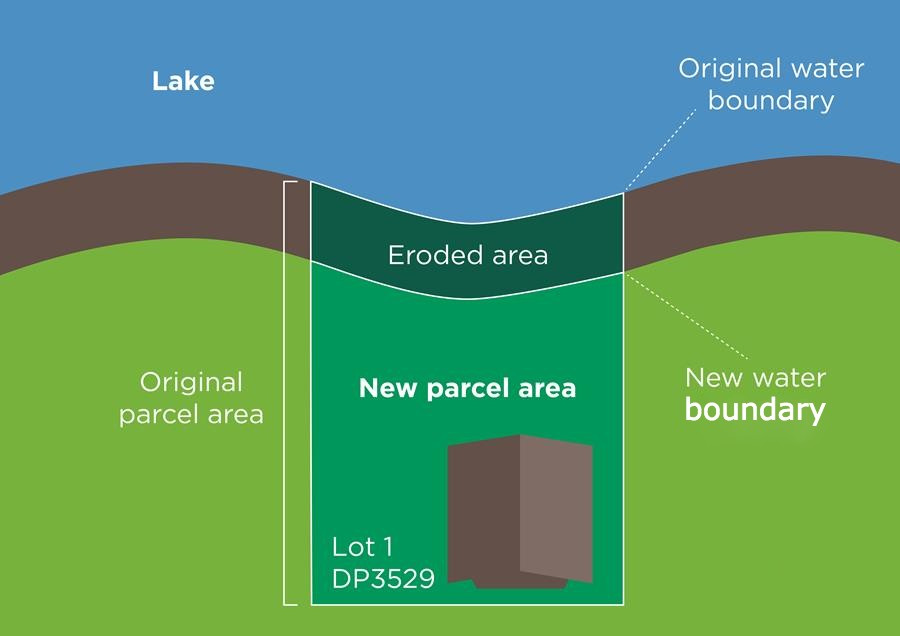
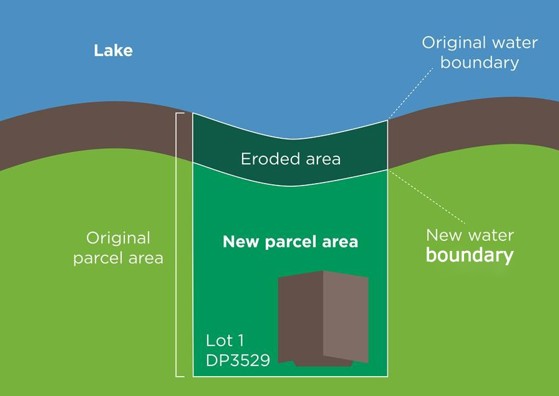
Where there is an esplanade reserve between the property parcel and the lake, because of the moveable boundary, the lake structure now occupies lakebed owned by TALT and water stratum owned by the crown. Therefore a ‘Right to occupy’ from Rotorua Lakes Council may not be required and lake structure owners will instead need to apply for a lease from LINZ.
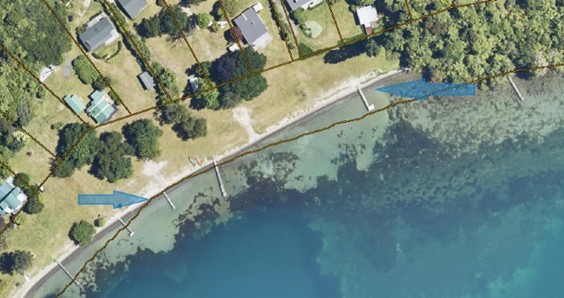
Lake Rotoiti Level Control Trial
For information on the Lake Rotoiti water level control trial, please visit the Lake Rotoiti page.
Cultural Management Plan for Ōkere Gates and Ōhau Weir:
Maintaining consented lake structures
Maintenance
Members of the public have a right to access and use any private jetty and to access public areas. For safety reasons owners must keep them maintained to a safe standard and notify Bay of Plenty Regional Council in writing (email notify@boprc.govt.nz) prior to any maintenance taking place. Maintenance must not extend beyond the existing footprint (including height) and it must be replaced ‘like for like’.
Building code
When you are undertaking maintenance works, you need to ensure that building code requirements are met. Maintenance works on boat sheds or lake structures do require building consent where:
- a component has failed to meet the durability of the requirements of the Building Code - 50 years for structural components and 15 years for the likes of cladding systems.
- the footprint of any structure is altered (unless the structure is a jetty with a fall height of under 1.5m).
For more information on building code requirements please contact Rotorua Lakes Council.
Lake structure repair and/or maintenance contractors
|
Steve Ross |
Stuart Dennis Urban Green Email: stuart@urbangreen.co.nz Mob: 027 478 7848 Note: can get a barge in if required |
| Ross Keyworth Tarawera Builders Email: rossnsuzy@slingshot.co.nz Phone: 027 710 2052 or 07 362 8404 Note – can get a barge in if required |
Mark Pemberton Traditional Landscapes Email: trad.landscapes@gmail.com Mob: 027 499 7794 |
| Lance Black Email: lance.black07@gmail.com Phone: 027 410 0291 |
Peter Hitchens Pete’s Landscaping and Maintenance Email: petehitland@gmail.com Mob: 027 500 6886 |
Habitat walls in the Rotorua Lakes
A habitat wall is a wall designed to provide cover habitat for kōura (endemic freshwater crayfish) and native fish species and may include suitable rock, rip rap, gabion baskets and timber structures (i.e., framing) or any combination of these materials. In addition, planting of native flora alongside the wall should be considered in achieving this purpose. You can learn more about habitat walls, how they help prevent erosion, provide habitat for kōura and other native fish species by checking out the video below
Habitat walls are favoured by landowners (TALT and LINZ), DOC and Bay of Plenty Regional Council as they provide a habitat for native species. Some lake edges in the Rotorua Te Arawa Lakes area are eroding, or existing retaining and erosion protection walls failing. We encourage those with existing unconsented retaining and erosion protection walls to apply for consent for these structures.
Bay of Plenty Regional Council have worked with TALT and the other agencies on an agreed mitigation measure that if and when the existing walls require replacement or the structure owner elects to replace the wall, that it is either replaced with a habitat wall or consideration for one is given in the first instance. Resource Consents for existing retaining walls include this requirement as a consent condition. As landowners TALT and LINZ have agreed that a lease would still be required for occupying the land (lake bed and water stratum) they administer but there wouldn’t be an annual charge.
Working with concrete in the lake
Installing or repairing underwater concrete structures is usually difficult, requiring specialised materials and installation systems as well as experienced engineers and operators.
If you want to use concrete to construct or repair structures in or near the lake, there are a few things to consider. If fresh concrete encounters water it makes it very alkaline, which is highly toxic to freshwater plants and animals. Particles from the concrete, including cement, grout and lime, can suffocate fish and smother aquatic plants. For more information refer to our Concrete Information Sheet.
Regular concrete cannot be placed underwater. When pouring concrete into or near the lake environment the workspace must be controlled and completely isolated from the surrounding water.
Alternatively, a tremie and pump system can be used to undertake underwater concrete works or repairs of a larger area. When smaller sections are to be placed or repaired, formworks or jackets can be installed, and voids filled by pumping polymer-modified grout.
You must also consider if your structure will experience geothermal conditions and design accordingly. Geothermal environments can quickly deteriorate concrete due to heat, moisture, acidic conditions and the presence of sulphates and chlorides. A special casing or protective layer, along with concrete additives, can help extend the structure's life.
If any earthworks are involved, you need to check the Regional Natural Resources Plan (Land Management – Rule 1) to see if the earthworks are permitted or need a resource consent.
Repairing jetty piles
As piles in the water deteriorate over time, repairing the piles may be the best way to extend the structure's life.
Consider that:
- A Structural Engineer must design any pile repair, replacement or new piles.
- Timber piles can be wrapped, encased or have a new section of pile spliced on top. Concrete or steel piles can be encased to regain structural integrity.
- For encased repairs, a casing is placed around the pile and filled with grout. This way the grout stabilises the pile and is contained within a sleeve, so it does not mix with the surrounding water.
Installing a new lake structure or modifying an existing lake structure
To minimise the impact of lake structures on the environment, their construction and maintenance requires a resource consent from the Bay of Plenty Regional Council. This also helps ensure that structures are appropriately maintained and safe, are not eyesores and do not interfere with important cultural aspects of the Rotorua Lakes.
Applying for consent
Before you consider applying for a resource consent for a new structure (or extension to existing structure), make sure you check out what existing structures are around. The lake owners and consent authorities will consider this when reviewing your application.
If you still want to proceed with a new lake structure (or extension to existing structure), and you’ve never applied for resource consent before, it pays to familiarise yourself with the resource consent process. When you’ve done this, please call our Duty Consents Officer on 0800 884 883. The first hour is free and they can help you make an informed decision about the best way forward, saving you time and money in the long run.
Please note that any application for a new lake structure (or extension to existing structure) will be assessed against the polices set out in the Regional and District Council plans. We recommend reading these before preparing any consent application. Depending on the location of the structure, the relevant Plans may include:
- Regional Natural Resources Plan
- Rotorua District Plan (this includes the Lakes A Zone)
- Tarawera River Catchment Plan
Read information on how much a resource consent would cost.
Consultation
When you’re ready to apply for resource consent, we recommend starting by discussing your proposal and obtaining written approval from the relevant lake owner(s)/administer(s) and affected parties. This will reduce the consent processing time and costs associated.
There are multiple parties you may need written approval from if your proposed structure occupies a lake/lakebed that they own, manage or administer. These parties include:
- Te Arawa Lakes Trust (TALT), owners of the lake beds for 14 lakes in the Rotorua rohe. Whether you are planning to build a new or modify an existing lake structure on a lakebed you are required to seek permission from Te Arawa Lakes Trust (TALT) as lakebed owner. This should be sought BEFORE an application for a Resource Consent is made. As part of the application process you will be asked how you have considered the cultural values of the Te Arawa lakes ie how your proposal impacts or enhances these. Te Arawa Lakes Trust recommends that prior to your lodging of the application you review their cultural values framework Te Arawa Cultural Values Framework - Te Arawa Lakes Trust as well as the iwi and hapū management plans associated to the lake. Please contact consent@tearawa.iwi.nz or 07 346 1761 for enquiries.
- The Crown owns the water and air space above the lake beds (referred to as the stratum). The stratum is administered by Land Information New Zealand (LINZ) on behalf of the Crown. Please contact Jan Webster, Portfolio Manager, on 04 460 2786 for queries.
- Department of Conservation (DOC), administers reserves and marginal strips at various locations around the lake/lake beds. Please contact the Community Ranger on 07 349 7400 or rotorua@doc.govt.nz.
- Rotorua Lakes Council, owners of reserves at various locations around the lakes. Please contact Robert Atkinson, Open Spaces Operations Advisor on 07 348 4199.
Approval may be via letter or lease/right to occupy form.
Who are the affected parties?
Affected parties are people or organisations who are not already identified as lake/lakebed owners, managers or administrators and might be more interested in, or more affected by, your activity than the general public. They are usually your immediate neighbours but can also include people who are farther away. We have listed some of the potentially affected parties above and another example is the Bay of Plenty Harbourmaster, Jon Jon Peters. He can be contacted on extension 0800 884 881 ext. 8411. Fish and Game are another affected party and Matt Osborne can be contacted on 07 357 5501 or via email mosborne@fishandgame.org.nz.
In addition to lakebed owner approval from TALT you will also be required to consult with local iwi and hapū; we can advise whom you will need to contact and provide contact details.
Approval from an affected party may be by letter or by filling in an Affected Person’s Form referenced at the bottom of this page.
Why do I need a lease?
Te Arawa Lakes Trust are landowners of the Te Arawa lakebeds and they administer and manage the Te Arawa Stratum. Land Information New Zealand (LINZ) administers the Crown Stratum on behalf of the Crown. The stratum includes the water column and airspace stratum (see diagram below). If your structure was installed post the Te Arawa Lakes Settlement Act (2006) you will require a lease from Te Arawa Lakes Trust and LINZ. A signed lease agreement is required with your application form.
Why do I need a Department of Conservation Lease/AFO (Agreement for Occupation)?
The Department of Conservation (DOC) administers reserves and marginal strips at various locations around Rotorua Te Arawa lakes. If your structure occupies DOC administered land then you require an Agreement for Occupation (AFO) from DOC. You will need to sign the AFO and return with your resource consent application form.
Why do I need a Rotorua Lakes Council Right to Occupy?
The Rotorua Lakes Council are owners of reserves at various locations around the Rotorua Te Arawa lakes. If your structure occupies council reserve land you will require a Right to Occupy from the Rotorua Lakes Council. You will need to sign the Right to Occupy and return it with your application form.
What support is available?
There are a range of qualified professionals that can support you through the consent process and getting the required technical information like engineering reports or ecological assessments. We’ve listed some Rotorua-based consultants below.
| Consultant | Contact details and/or notes |
|---|---|
| Stratum Consultants |
1268 Haupapa Street, Rotorua
|
| Sigma Consultants Ltd | 1281 Hinemoa St PO Box 553, Rotorua 3040 07 347 3456
|
| Cheal Consultants (Canmap Hawley Ltd) | 1180 Amohia Street PO Box 396, Rotorua 3040 07 349 8470
|
| Wildland Consultants Ltd | 99 Sala Street Rotorua 3010 07 343 9017
|
| WSP | 1105 Arawa Street PO Box 1245, Rotorua 07 343 1400
|
| APR Consultants | 1209 Hinemaru St, Rotorua 3010 info@apr.co.nz 07 349 8333 |
| BSK Engineers | 314 Malfroy Road admin@bsk.co.nz 07 348 5394
|
| Marine Flex Ltd | Mike & Donna Baker 12 Kent Street, Picton 7220 027 4452 379
|
| Greenfield Diving Services | 55 Winchester Terrace, Bethlehem, Tauranga 3110 027 2499 923
|
Fixed versus natural boundaries
Most of Rotorua's lakeside properties have natural boundaries rather than fixed boundaries, which are straight lines between points or pegs established by surveys.
Natural boundaries are defined by ground features such as the banks of rivers, lakes and tidal waters. A natural boundary means that when accretion (land has gradually accumulated) or erosion take place the landowner may become entitled to more or less land than that originally comprised in their title.
This means that the land title register and plans which support it do not control the extent of the parcel on the ground, it is the moving boundary which controls the extent of the parcel at any given point in time.
For example, if land area is reduced due to water erosion it becomes part of the lakebed/stratum, then it will become property of TALT/LINZ.

Where there is an esplanade reserve between the property parcel and the lake, because of the moveable boundary, the lake structure now occupies lakebed owned by TALT and water stratum owned by the crown. Therefore a ‘Right to occupy’ from Rotorua Lakes Council may not be required and lake structure owners will instead need to apply for a lease from LINZ.

Modifying existing lake structure
If you are looking to modify an existing lake structure so it’s no longer ‘like for like’, or so it sits outside of the existing footprint, then resource consent and approval from the lakebed owner would be required prior to any works being carried out. TALT owns 14 lakebeds in the Rotorua area, but some structures are within DOC owned marginal strips or Rotorua Lakes Council reserves. Consent from TALT after modifications have taken place will not be approved. Information about modifying an existing structure can be found on the TALT website or by emailing consent@tearawa.iwi.nz
Boat Lifters
Annexing a boat lifter to an existing structure is a modification of that structure. Although boat lifters can be removed, they are not transient, and are intended to be in place for long periods of time.
Accordingly, landowner approval from TALT must be sought before putting a boat lifter into a Te Arawa lake by filling in a consent application on the TALT website. Applications will be considered on a case-by-case basis.
- Keep an eye on pollution incidents on land, in water and air and report them to the BOPRC Pollution Hotline on 0800 884 883 which operates 24/7. You can also contact the hotline regarding compliance issues, such as diggers in our lakes or unexpected new structures.
- A reminder that ratepayers and residents need permission from TALT for lakes structures.
Houseboats on the Rotorua Lakes
The Lakes A zone and the Operative District Plan both require resource consents for occupation of a boat as a household unit. There are various considerations for an activity of this type including wastewater disposal, visual and landscape effects and cultural effects to name a few. We would suggest making an appointment with Rotorua Lakes Council’s duty planner to discuss the likely information requirements in regard to any resource consent application before lodging a resource consent application. Contact them via phone number: 348-4199.
Te Arawa Lakes Trust are drafting their policy regarding houseboats on the Rotorua Te Arawa Lakes. Please contact the Te Arawa Lakes Trust consent team consents@tearawa.iwi.nz prior to placing a houseboat on the lakes as landowner approval may be required.
There are some considerations from a Navigational Safety Bylaw viewpoint; these pertain to the below:
2.6.4 The owner or master of a vessel at anchor, moored, or berthed at a wharf, must ensure that it is securely fastened at all times and, if required by the Harbourmaster, maintain a person on board to keep watch.
We are encouraging comment on the bylaw review, tell us what you think.
Bay of Plenty Regional Council previously sought legal advice on houseboats in regard to anchoring and whether they are considered to be a ‘structure’ under the Resource Management Act 1991. The legal advice received said this depended on the method of mooring, the duration of mooring and possibly whether the vessel can move under its own steam or by sail. We would need more information from the houseboat owner to be able to advise on this.
Access our online consent forms and guidelines for lake structures here.
Forms relating to a change, surrender or transfer of consent are located under other forms.
Downloads
- Lake structures need a consent: a guide
- Existing unconsented moorings
- Apply for consent for your existing retaining and erosion protection wall
- New Zealand dabchick (weweia) factsheet
- Lake Rotorua Cultural Mapping Report
- Lake Rotomā Cultural Mapping Report
- Lake Rotoehu Cultural Mapping Report
- Lake Ōkāreka Cultural Mapping Report
- Lake Tarawera Cultural Mapping Report
- Lake Rotoiti Cultural Mapping Report - Note this report does not include comments from Ngāti Mākino whom Regional Council are still working with in regards to cultural effects on lake structures.
- Addendum to the Lake Rotoiti Cultural Mapping Report
- Cultural Mapping Reports for the Other Lakes
- Indigenous Planting on the Margins of the Rotorua Lakes
Please also note that earlier this year TALT formally advised BOPRC Consents Team that because of the biosecurity risk, the cultural assessments for all existing private boat ramps in the cultural mapping reports would now be assessed as having more than minor adverse effects.

